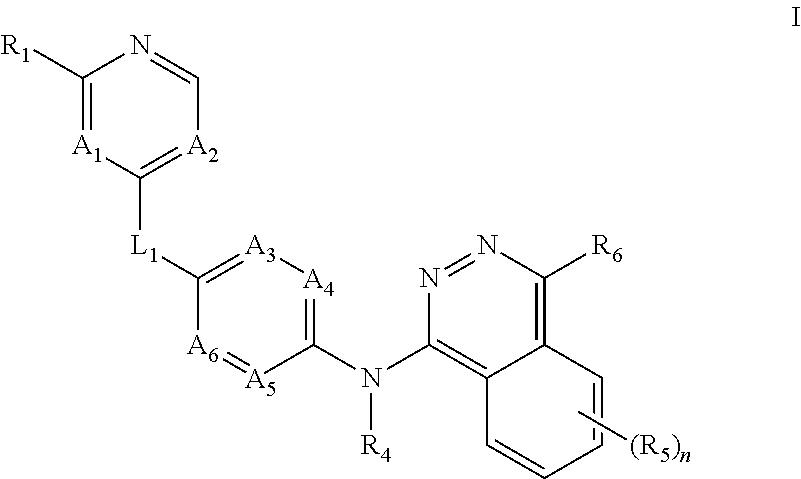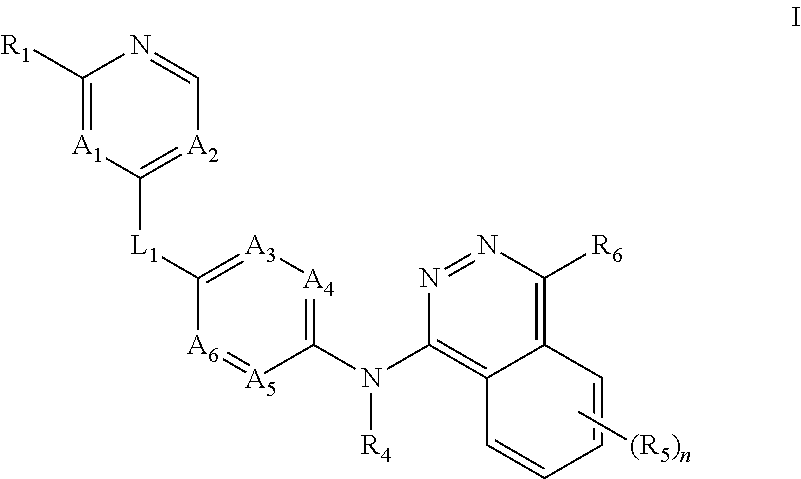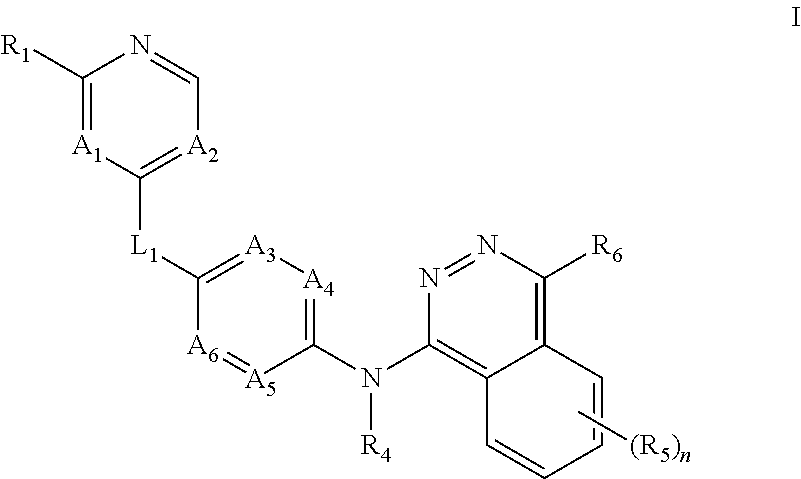Aurora kinase modulators and methods of use
a technology of aurora kinase and modulator, which is applied in the field of modulating aurora kinase, can solve the problems of affecting mankind and a major cause of death worldwide, few cancer treatments and therapies that offer any considerable degree of success, and loss of normal cell proliferation regulation
- Summary
- Abstract
- Description
- Claims
- Application Information
AI Technical Summary
Benefits of technology
Problems solved by technology
Method used
Image
Examples
example 1
[0249]
4-((4-(((4-(4-Chlorophenyl)-1-phthalazinyl)amino)phenyl)thio)-N-methyl-2-pyridinecarboxamide
[0250]A resealable tube was charged with 4-(4-aminophenylthio)-N-methylpicolinamide (0.075 g, 0.29 mmol) and t-butanol (1.0 mL). 1-Chloro-4-(4-chlorophenyl)phthalazine (0.080 g, 0.29 mmol) was added, and the tube was flushed with argon and sealed. The mixture was stirred at 100° C. for about 19 h. The reaction mixture was concentrated and the residue was triturated with DCM and filtered to afford 4-((4-((4-(4-chlorophenyl)-1-phthalazinyl)amino)phenyl)thio)-N-methyl-2-pyridinecarboxamide as an off-white solid. MS m / z=498 [M+H]+. Calc'd for C27H20ClN5OS: 498.01.
example 2
[0251]
N-(4-((2-(methylthio)-4-pyrimidinyl)oxy)phenyl)-4-phenyl-1-phthalazinamine
[0252]4-Chloro-2-(methylthio)pyrimidine (77.8 μl, 674 μmol), 4-(4-phenylphthalazin-1-ylamino)phenol (211 mg, 674 μmol), cesium carbonate (659 mg, 2020 μmol), and N,N-dimethylformamide (1347 μl, 0.500 M) were combined in a microwave vial, and the vial was sealed. The reaction mixture was heated in the microwave to 150° C. for 10 minutes. Upon cooling, LCMS analysis showed nearly complete conversion to N-(4-((2-(methylthio)-4-pyrimidinyl)oxy)phenyl)-4-phenyl-1-phthalazinamine. The reaction mixture was heated to 150° C. for an additional 10 minutes, and the reaction progress was again checked by LCMS, which showed complete conversion. 500 uL of NEt3 was added, and the mixture was allowed to stir for 1 hour. The mixture was diluted with water and CH2Cl2. The water layer was separated and extracted 2× with CH2Cl2. The combined organic extracts were dried over MgSO4, filtered and concentrated in vacuo. The res...
example 3
[0253]
4-(4-Chlorophenyl)-N-(4-(2-(2-(methylamino)ethylamino)pyrimidin-4-ylthio)phenyl)phthalazin-1-amine
[0254]A resealable tube was charged with 1-chloro-4-(4-chlorophenyl)phthalazine (0.22 g, 0.80 mmol), tert-butyl 2-(4-(4-aminophenylthio)pyrimidin-2-ylamino)ethyl(methyl)carbamate (0.150 g, 0.40 mmol) and 2-butanol (3.0 mL). The tube was flushed with argon and sealed. The mixture was stirred at 100° C. for about 3 hrs. The reaction was cooled to RT and concentrated. The concentrate was dissolved in 5 mL of DCM and TFA (5.00 ml, 65 mmol) was added. The reaction was stirred for 30 minutes at RT. The reaction mixture was concentrated and the crude material was purified on a Gilson HPLC (gradient elution 10-90% MeCN:H2O) system to afford the titled compound as a light yellow solid. MS m / z=514 [M+H]+. Calc'd for C27H24ClN7S: 514.04
PUM
| Property | Measurement | Unit |
|---|---|---|
| flow rate | aaaaa | aaaaa |
| flow rate | aaaaa | aaaaa |
| time | aaaaa | aaaaa |
Abstract
Description
Claims
Application Information
 Login to View More
Login to View More - R&D
- Intellectual Property
- Life Sciences
- Materials
- Tech Scout
- Unparalleled Data Quality
- Higher Quality Content
- 60% Fewer Hallucinations
Browse by: Latest US Patents, China's latest patents, Technical Efficacy Thesaurus, Application Domain, Technology Topic, Popular Technical Reports.
© 2025 PatSnap. All rights reserved.Legal|Privacy policy|Modern Slavery Act Transparency Statement|Sitemap|About US| Contact US: help@patsnap.com



